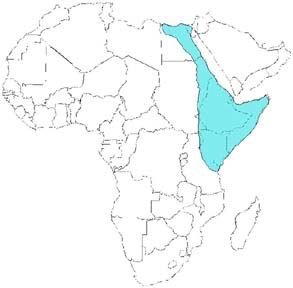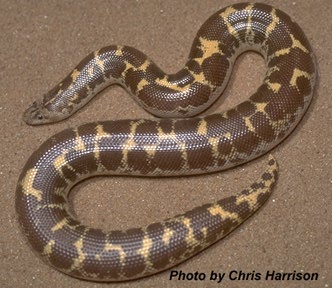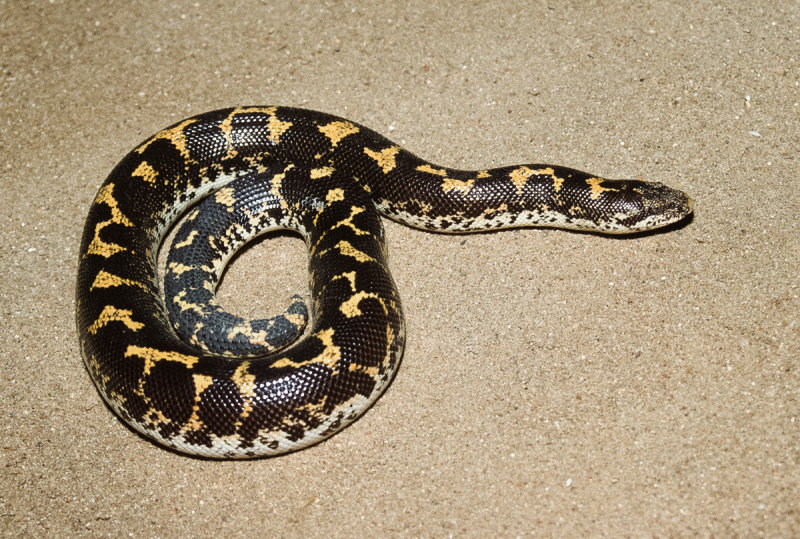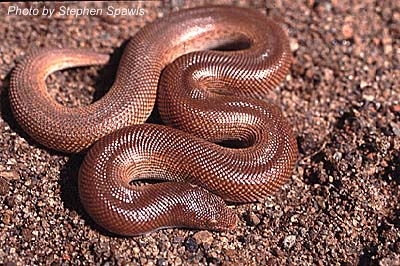Posted by:
chrish
at Sat Aug 3 11:01:33 2013 [ Report Abuse ] [ Email Message ] [ Show All Posts by chrish ]
Kenyan and Egyptian Sandboa are both common names for the same species of snake, Eryx colubrinus. That snake is probably more correctly known as the East African Sandboa since it occurs across a wide area of eastern Africa.
Here's an approximate range map for the species -

So it effectively ranges from northern Tanzania through Kenya up through the Sudan to Egypt and then over to the horn of Africa in Ethiopia and Somalia.
Just like any other wide ranging species of snake, animals from one end of the range look a bit different than others from the other end of the range. In the northern parts of the range (in Egypt) they snakes tend to be pale yellow in the ground color with blotches of chocolate brown.
Here is a specimen that actually came from Egypt. IIRC, it was confiscated by USFWS from an illegally imported shipment out of Egypt -

As you go south in the range, the snakes become darker and the ground color becomes more orange and the blotches become more black. These more orange and black snakes were described as a separate subspecies by Stull and given the name Eryx colubrinus loveridgei. This subspecies was later given the name "Kenyan Sandboa". However, all the authorities that have looked at this species across its whole range have rejected the validity of the two subspecies saying that it is simply one taxon of snake that varies from one end of the range to other.
Actually the most colorful of the "Kenyan" Sandboas and most of the lineages in the US didn't even come from Kenya, they were exported from Tanzania (south of Kenya). People with experience in Kenyan have told me that the snakes in Kenya vary from yellow to orange depending on where you are.
Here is a wild caught Tanzanian specimen of Eryx colubrinus -

They can be more orange than this specimen. Specimens from the vicinity of Dodoma, Tanzania are generally regarded as the most colorful regional variant and many captive lineages of "Kenyan" Sandboa are now derived from that Tanzanian bloodline.
In the captive population, hobbyists have further screwed up this delineation by selling snakes as Kenyan or Egyptian not based on their country of origin but their color phase. I actually saw a person at an expo many years ago with a big group of captive born baby sandboas and he was selling some as Kenyan for higher prices and some as Egyptian for lower prices. Problem was they were all from the same clutch of snakes!
When I first got interested in this species (~25 years ago?) the only readily snakes in the hobby were wild caught snakes out of "Egypt". They were the standard yellow/brown snakes. They were cheap, but people really wanted the more expensive Kenyans which were still hard to get. Then people started breeding Kenyans a lot and the price dropped way down. When the imports out of the northern parts of the range stopped, suddenly Egyptian Sandboas became more valuable. Some people started selling their paler Kenyans as Egyptians. The result is that very few, if any, of the captive lineages of Eryx colubrinus can be traced to a particular region or origin anymore.
There is another color phase of Eryx colubrinus that occurs in Ethiopia and Somalia that was originally described as Eryx rufescens. This color phase is a solid chocolate brown snake. When bred back to the "normal" color phases, they produce striped snakes with solid brown sides and orange striped backs.
Here is a photo of a wild caught "rufescens" phase Eryx colubrinus from northeastern Ethiopia -

A good analogy for understanding East African Sandboas is to compare them to California Kingsnakes. In some parts of their range (the eastern areas) Cal Kings are banded black and white. As you move west towards the coast, you run into snakes that are banded brown and white or even brown and yellow. Same species of snake and the black/white and brown/yellow snakes don't get subspecies designations because there is a fairly smooth cline from east to west. In one area of their range (San Diego area), there is a gene which produces a striped pattern. In this area, many of the snakes are striped. As you move away from that area you find snakes that are unusual mixes of striped and banded or somewhere in between.
In East African Sandboas, there is the same pattern. At one end of their range they are brown/yellow and as you move to the other end they get progressively more black/orange. In one area there is a genetic mutation which causes the snake to come out solid brown. If solid brown snakes mate with normally patterned snakes they end up with an intermediate striped pattern.
This is why they are generally considered to be variant color patterns of the same taxon of snake and the subspecies E.c.colubrinus, E.c.loveridgei, and E.c.rufescens are all regarded as invalid.
And unfortunately, you can't really evaluate the taxonomic validity of any of these names by looking at captive populations. You have to look at the distribution of the particular color patterns and phases in wild snakes of specific known localities, and you have to see numbers of individuals from those localities. The last person to do that scientifically (Anatoly Tokar) found that the subspecies are not real.
So calling them Kenyan and Egyptian Sandboas is like distinguishing between Florida and South Carolina Cornsnakes. They may look different most of the time, but they are just variations on the same species of snake.
-----
Chris Harrison
San Antonio, Texas
[ Reply To This Message ] [ Subscribe to this Thread ] [ Hide Replies ]
|



